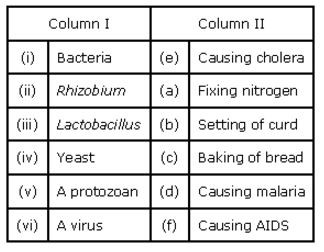(EXERCISE PAGE 31)
1:Fill in the blanks:
(a) Microorganisms can be seen with the help of a _________.
(b) Blue green algae fix _________ directly from air to enhance fertility of soil.
(c) Alcohol is produced with the help of ________. (d) Cholera is caused by________.
Ans:(a) Microscope (b) Nitrogen (c) Yeast (d) Bacteria
2: Tick the correct answer:
(a) Yeast is used in the production of (i) sugar (ii) alcohol (iii) hydrochloric acid (iv) oxygen
(b) The following is an antibiotic (i) Sodium bicarbonate (ii) Streptomycin (iii) Alcohol (iv) Yeast
(c) Carrier of malaria-causing protozoan is (i) female Anopheles mosquito (ii) cockroach (iii) housefly (iv) butterfly
(d) The most common carrier of communicable diseases is (i) ant (ii) housefly (iii) dragonfly (iv) spider
(e) The bread or idli dough rises because of (i) heat (ii) grinding (iii) growth of yeast cells (iv) kneading
(f) The process of conversion of sugar into alcohol is called (i) nitrogen fixation (ii) moulding (iii) fermentation (iv) infection
Ans:(a) Alcohol (b) Streptomycin (c) Female Anopheles mosquito (d) Housefly (e) Growth of yeast cells (f) Fermentation .
3: Match the organisms in column A with their action in Column B.
| Column A | Column B |
| (i) Bacteria | (a) Fixing nitrogen |
| (ii) Rhizobium | (b) setting of curd |
| (iii) Lactobacillus | (c) Baking of bread |
| (iv) Yeast | (d) Causing malaria |
| (v) A protozoan | (e) Causing cholera |
| (vi) A virus | (f) Causing AIDS |
| (g) Producing antibodies |
Ans:

4:Can microorganisms be seen with the naked eye. If not, how can they be seen.
Ans:Micro-organisms are too small to be seen through naked eyes. They can be seen with the help of a magnifying glass or microscope. For example, fungus that grows on bread is so small that it can be seen only with the help of a magnifying glass or microscope.
5:What are the major groups of microorganisms.
Ans:
There are five major groups of micro-organisms:
Bacteria: They are single celled disease-causing micro-organisms. They can be spiral or rod- shaped.
Fungi: They are mostly multicellular disease-causing microbes. Bread moulds are common examples of fungi.
Protozoa: They mainly include organisms such as Amoeba, Plasmodium, etc. They can be unicellular or multicellular.
Virus: Viruses are disease-causing microbes that reproduce only inside the host organism.
Algae: They include multicellular, photosynthetic organisms such as Spirogyra, Chlamydomonas, etc.
6: Name the microorganisms which can fix atmospheric nitrogen in the soil.
Ans: Bacteria such as Rhizobium and certain blue-green algae present in the soil can fix atmospheric nitrogen and convert it into usable nitrogenous compounds. These nitrogenous compounds can be easily utilized by plants for the synthesis of plant proteins and other compounds.
7: Write 10 lines on the usefulness of microorganisms in our lives.
Ans: Importance of micro-organisms:
1. They are used in wine making, baking, pickling, and other food making processes.
2. Alcoholic fermentation by yeast is widely used in the preparation of wine and bread. A bacterium Lactobacillus, promotes the formation
of curd.
3. Yeast reproduces rapidly and produces carbon dioxide during respiration. Bubbles of the gas fill the dough and increases its volume.
4. Microbes are used to reduce pollution. Decomposers such as bacteria and fungi break down dead bodies and excreta to form inorganic
compounds, which can be absorbed by plants.
5. They are used to increase the soil fertility by fixing the atmospheric nitrogen with the help of bacterium Rhizobium and some other blue-
green algae.
6. Microbes also play an important role in the preparation of medicines.
7. Antibiotics are chemicals produced by micro-organisms to kill bacteria. Streptomycin, for example, is an antibiotic.
8. Certain microbes are also used in the biological treatment of sewage and industrial effluents.
9. Antibiotics are used to control many plant diseases
10. Antibiotics are mixed with the feed of livestock and poultry to check microbial infection in animals.
8: Write a short paragraph on the harms caused by microorganisms.
Ans: Harmful effects of micro-organisms:
1. Micro-organisms cause diseases in animals. e.g., in humans, bacteria cause diseases such as tuberculosis, cholera, typhoid, etc.
2. In cattle, the foot and mouth disease is caused by a virus.
3. Also, several microbes cause diseases in plants. e.g., the productivity of wheat, orange, apple, etc. is reduced due to microbial diseases in plants.
4. Certain microbes, on entering into our body, produce toxic substances. This leads to food poisoning.
5. Some micro-organisms such as fungus spoil our food. e.g., bread when left unused under moist conditions gets spoilt by fungus, producing a white cotton-like growth on the bread.
9: What are antibiotics. What precautions must be taken while taking antibiotics.
Ans: Antibiotics are medicines produced by certain micro-organisms to kill other disease-causing micro-organisms. These medicines are commonly obtained from bacteria and fungi. Streptomycin, tetracycline, penicillin, etc. are common antibiotics.
Precautions to be taken while using antibiotics:
Antibiotics should be taken under the supervision of a well-qualified doctor.
Course (intake) of antibiotics should be completed as per the prescription given by the doctor.
Antibiotics should be taken in the right amount and at the right time. A wrong dose of antibiotic makes the drug ineffective. Also, excessive consumption of drugs may kill the useful bacteria present in our body.

